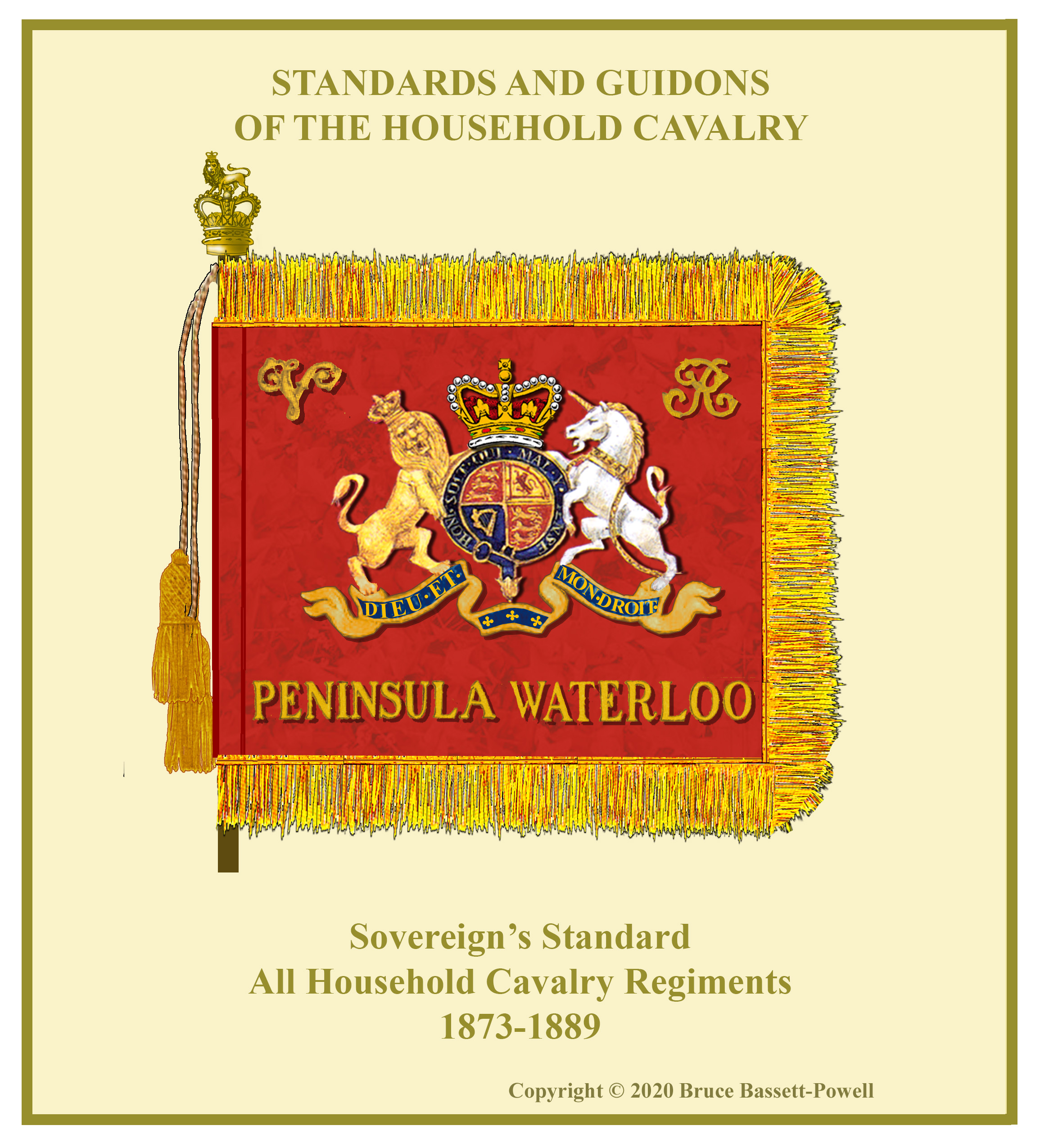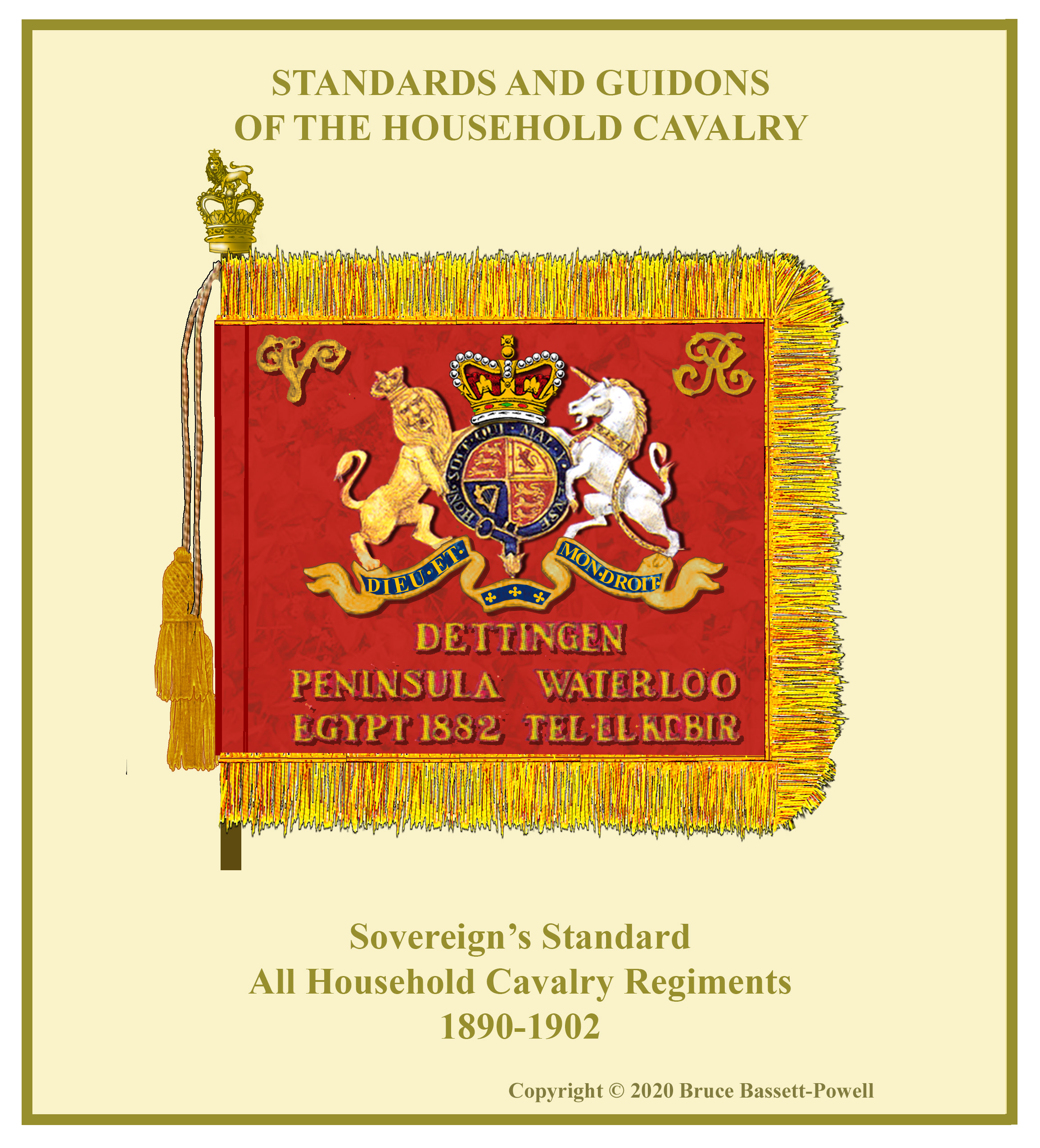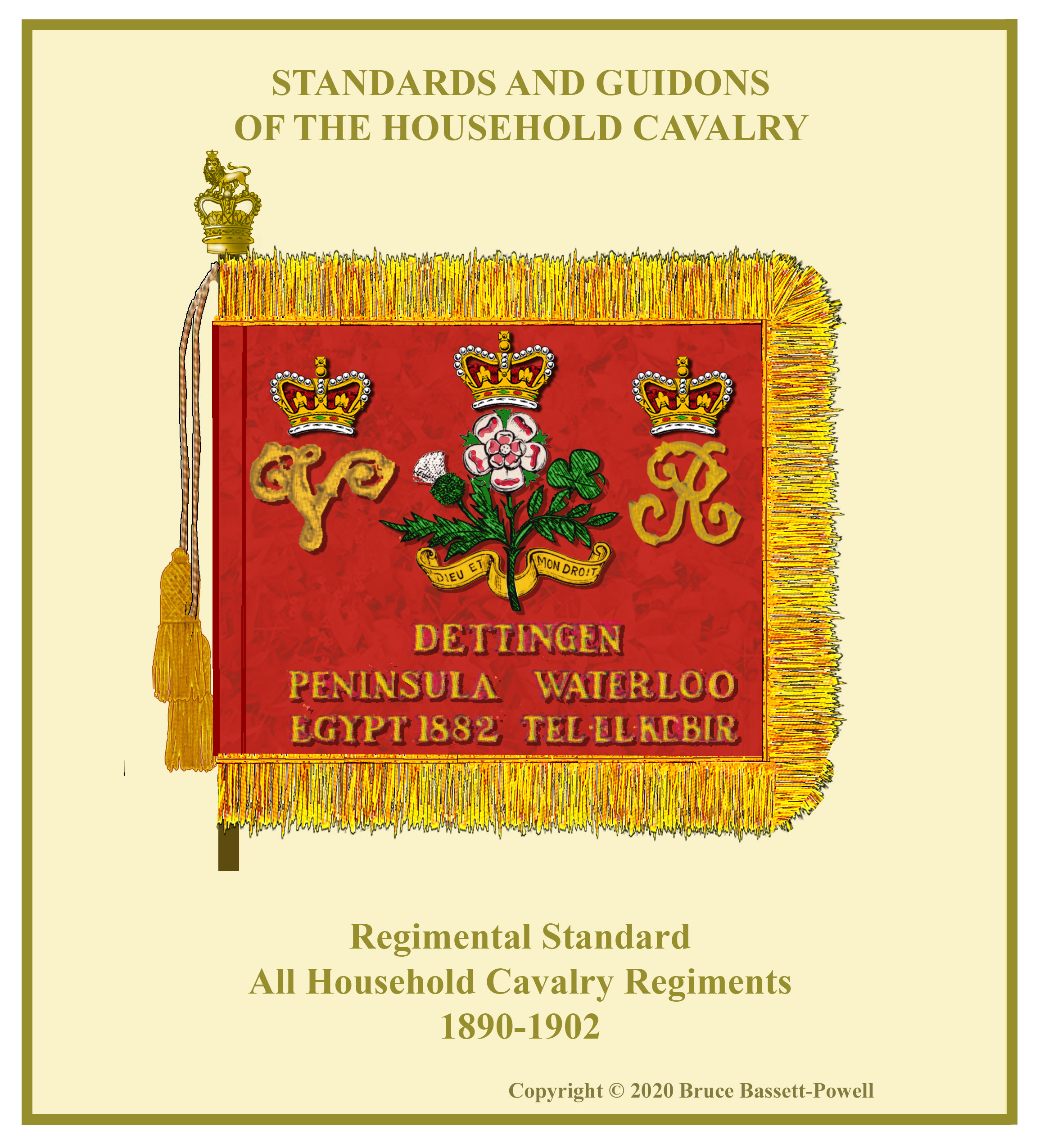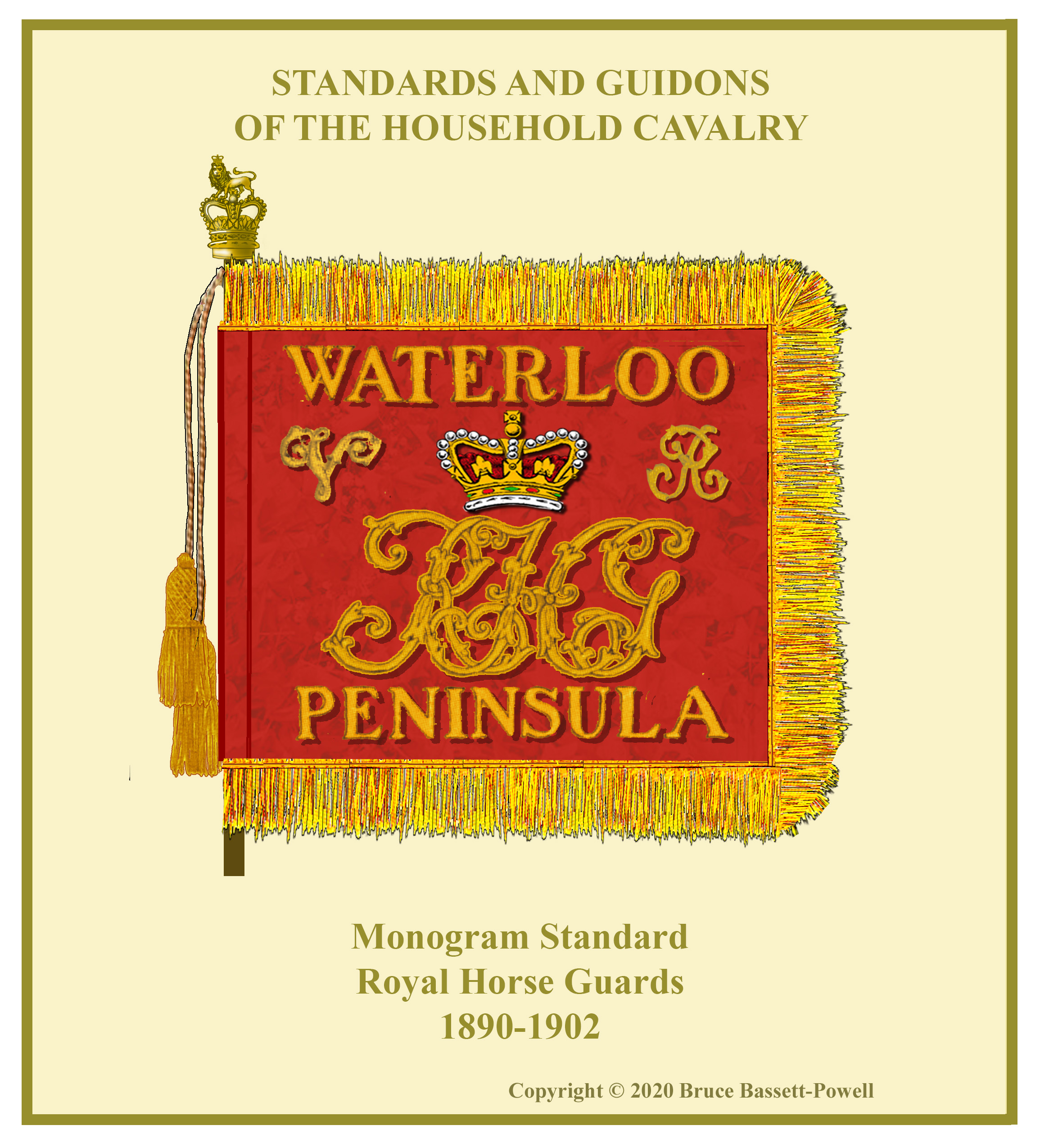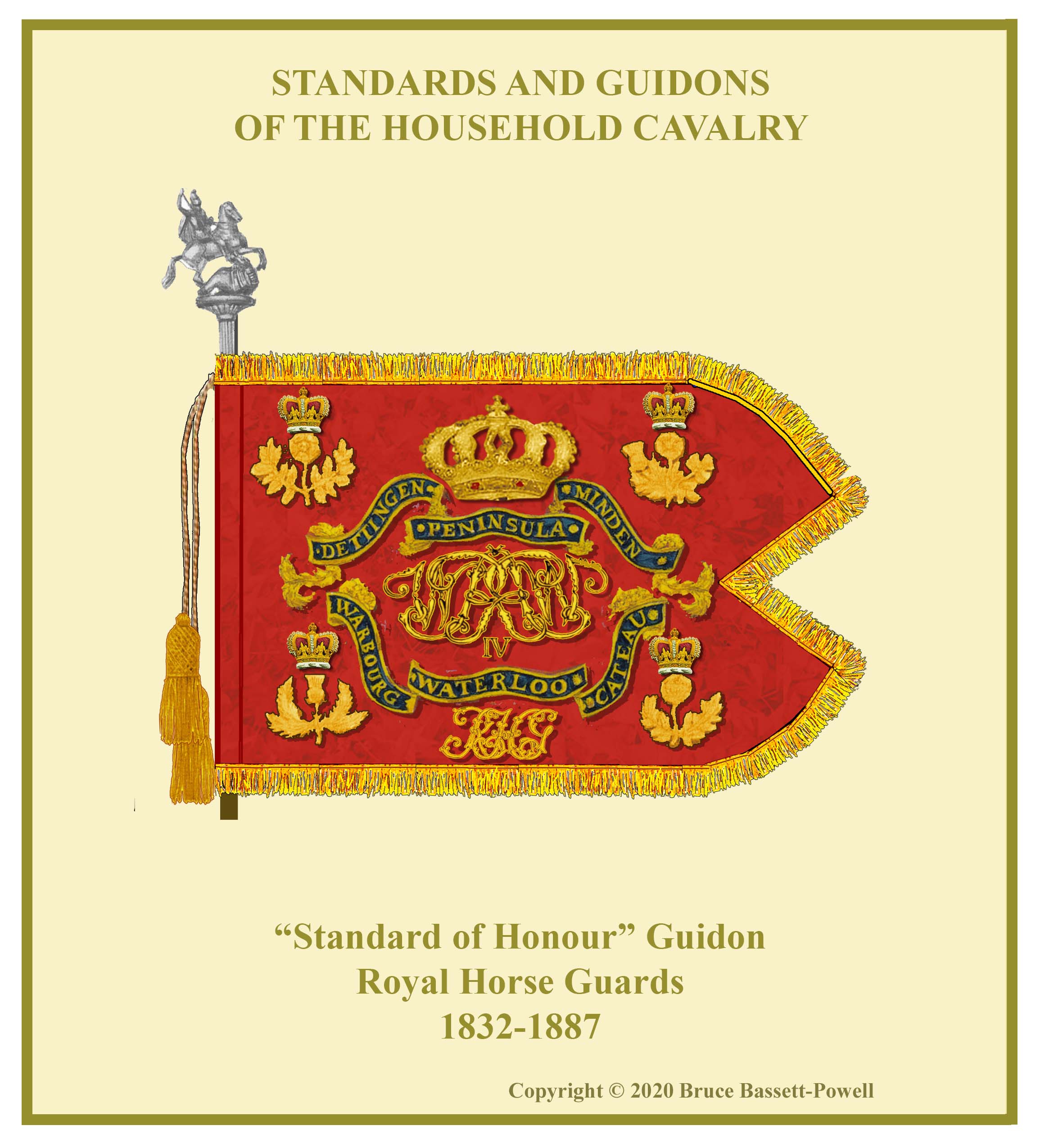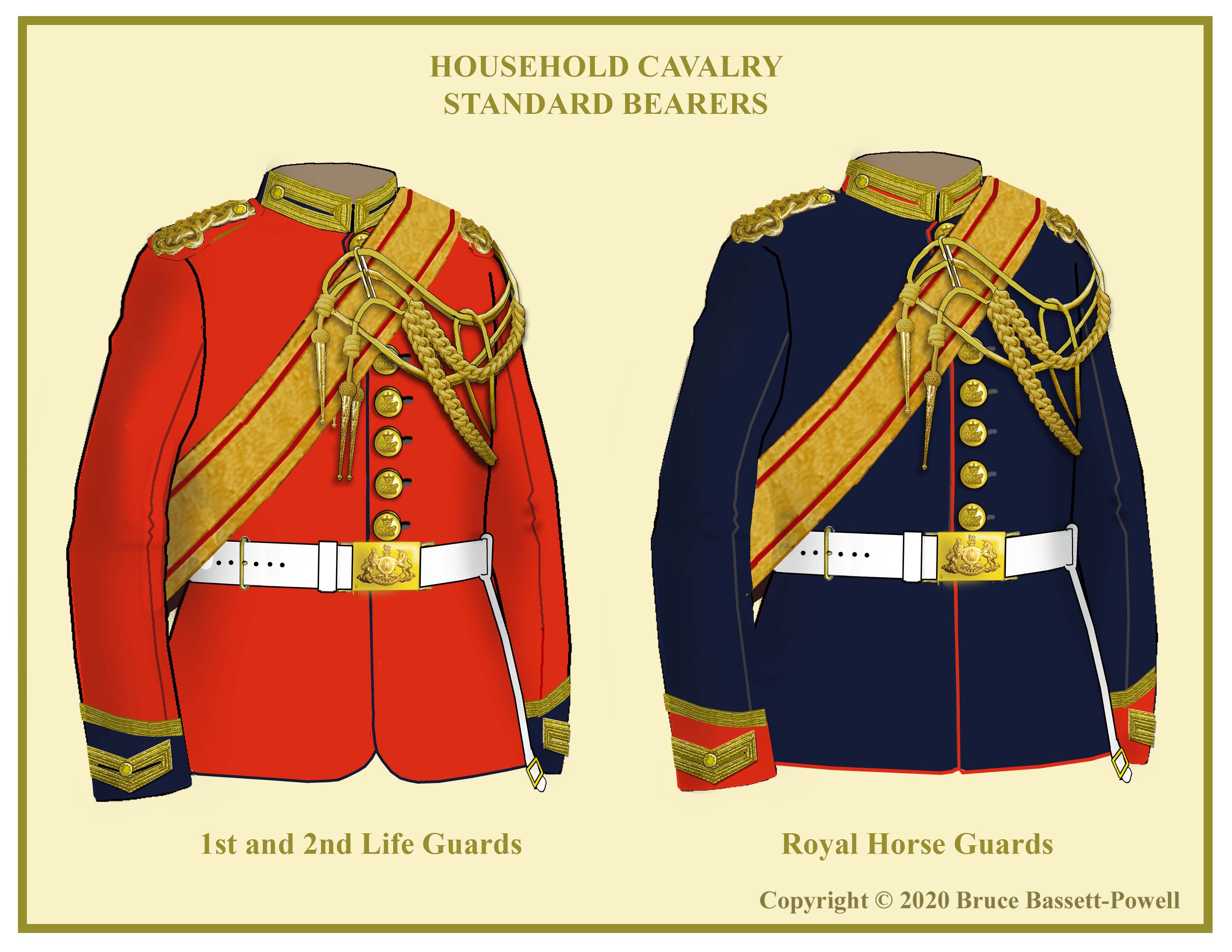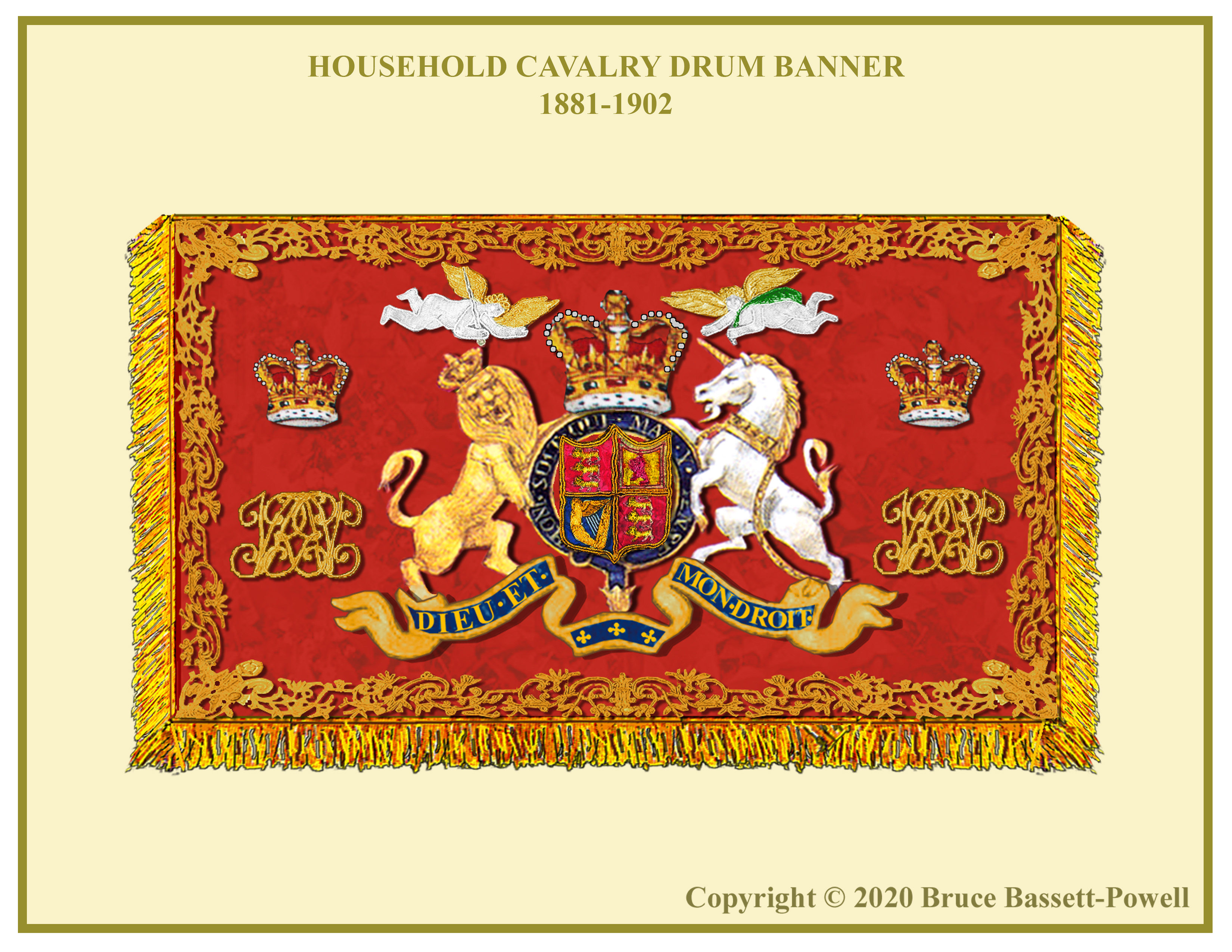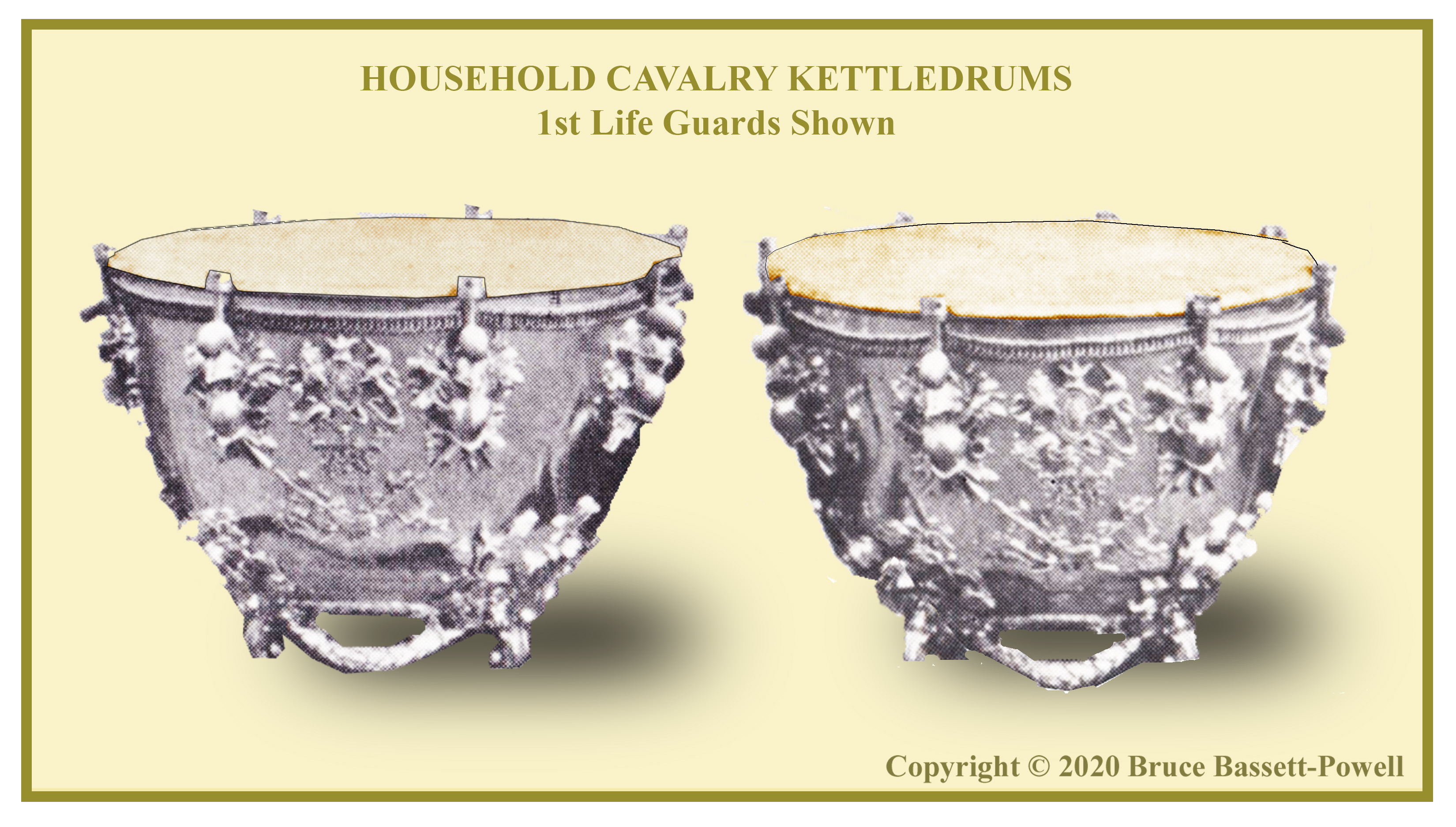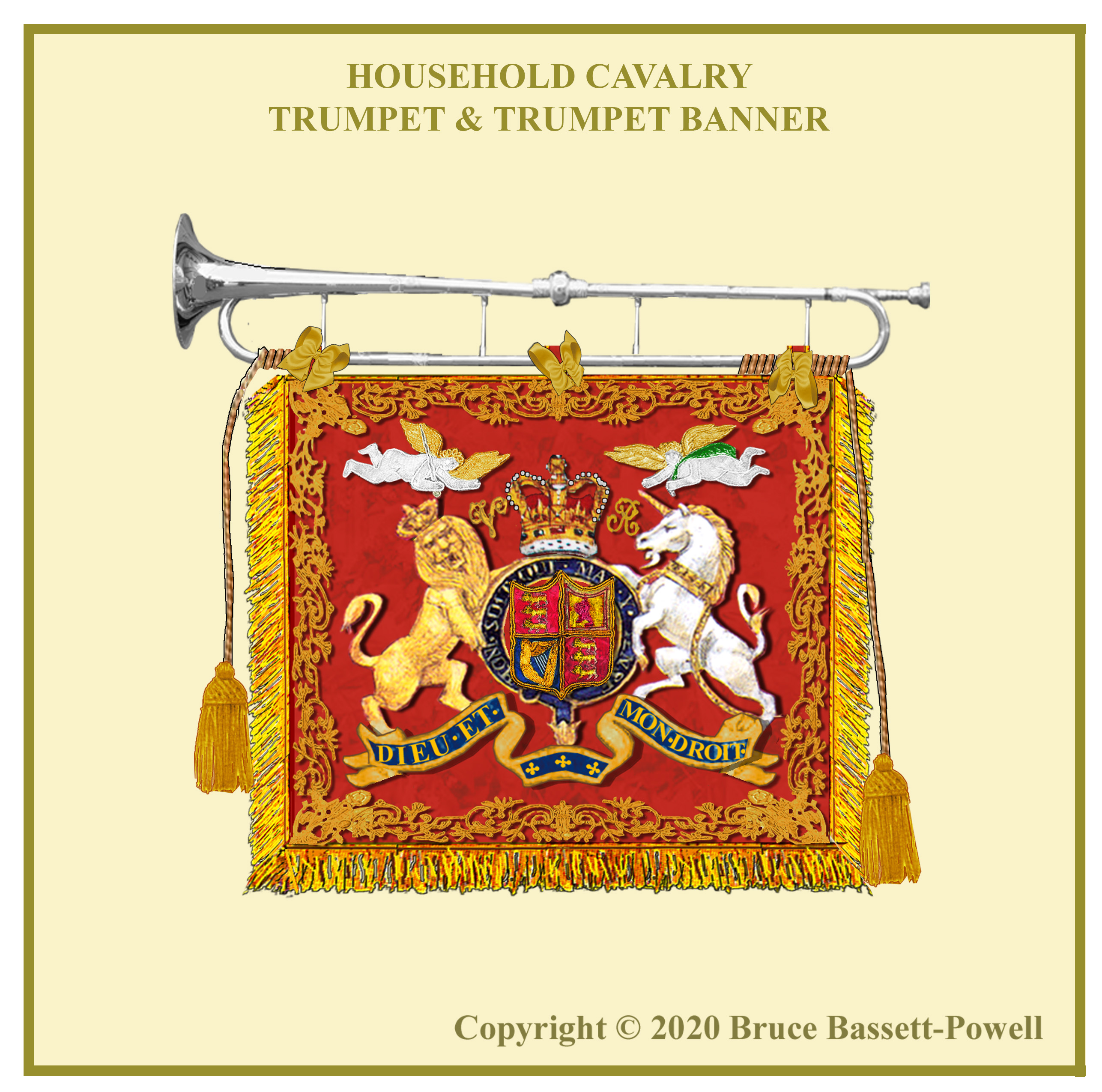HOUSEHOLD CAVALRY
STANDARDS, DRUM AND TRUMPET BANNERS
SOVEREIGN'S & REGIMENTAL STANDARDS
The Household Cavalry has always retained a great deal of independence in the design and the number of standards and guidons they have carried. From the beginning, the issuance and purchasing of standards lay with the Lord Chamberlain’s office as part of the Royal Household.
However, from 1863, this responsibility was given to the War Office, which regulated such matters for the whole army. Like the rest of the heavy cavalry, issuance of new standards came with little or no fanfare or ceremony.
The regulations of 1858 changing the size of standards had little impact on the Household Cavalry, especially that element that ordered only one standard per regiment. They continued to carry one standard per squadron. In 1873 the Inspector General felt that battle honours borne above the Royal Crown would not be allowed, so the battle honours of Waterloo and Peninsula were placed on the lower edge of the standard. At the same time, the size of Standards was again reduced to 2ft 6 ins wide by 2ft 3 ins on the staff. The Royal Cypher standard of the Royal Horse Guards, which had the Royal Cypher in the centre instead of the Royal Arms, was discontinued. (Despite the Inspector General's feelings, the regiment did not change their standard until after 1902.)
In 1881, the standards carried by the Household cavalry were as follows: The 1st & 2nd Life Guards, two Sovereign’s Standards and two Regimental Standards. The Royal Horse Guards carried one Sovereign’s Standard, two Regimental (Union Badge) standards and a Monogram standard. In addition, they carried a special Guidon presented to them by William IV in 1832. The King, like his father had a great affection for the Blues. It was a particularly attractive gift with much gold embroidery and most of its battle honours emblazoned upon it. The finial on the staff was an ornate depiction of St. George slaying the Dragon in silver. The Guidon was paraded for the last time in 1887 and remains to this day at the Household Cavalry Museum at Windsor.
All the household cavalry regiments earned the battle honours “EGYPT 1882” and TEL-EL-KEBIR in 1883. Prior to that in 1882, their Lordships had finally recognized that the battle honour of “DETTINGEN” should be awarded nearly 140 years after the battle was fought.
In 1890, the regulations once more reduced the size of standards to 2ft 5 ½ ins in the fly and 2ft 2 ins on the staff. Later that year, the Household Cavalry were issued with standards that would be the same size as they are today and the same style with changes only with crowns, cyphers and battle honours. The amalgamations of the Life Guards in 1928 saw no changes in the basic design. The Royal Horse Guards Monogram standard was carried for the last time in 1927.
InAll the household cavalry regiments earned the battle honours “EGYPT 1882” and TEL-EL-KEBIR in 1883. Prior to that in 1882, their Lordships had finally recognized that the battle honour of “DETTINGEN” should be awarded nearly 140 years after the battle was fought.
In 1890, the regulations once more reduced the size of standards to 2ft 5 ½ ins in the fly and 2ft 2 ins on the staff. Later that year, the Household Cavalry were issued with standards that would be the same size as they are today and the same style with changes only with crowns, cyphers and battle honours. The amalgamations of the Life Guards in 1928 saw no changes in the basic design. The Royal Horse Guards Monogram standard was carried for the last time in 1927
Carriage Belts
The carriage belts for the standard bearer (Always a Squadron Corporal-Major) was of gold lace with two crimson cloth stripes at each side. They continued to be worn to this day.
KETTLE DRUMS, DRUM AND TRUMPET BANNERS
From the very beginning, the Life Guards paraded with kettle drums. They apparently led King Charles II into London in 1660. Naturally, the drums were draped with banners that carried the arms, cyphers and symbols of the Monarch. As Household troops, all three regiments’ banners were similar. By the time Queen Victoria came to the throne, the design on the banners would be established as a pattern that continues to this day with changes only reflecting the Monarch of the day. In the early days of Victoria’s reign the banners were entirely made by hand and close up appear quite crude compared with later examples where more precision seems to have been employed.
On the 23rd of April, St. George’s Day, 1805 George III presented a magnificent pair of silver kettledrums to the Royal Horse Guards. As has been previously stated, the Blues were his favourite regiment and he wore their uniform almost daily. It was his second son who as William IV presented a set of silver drums to the 1st Life Guards on 6th May, 1831 and another pair to the 2nd Life Guards on the 22nd July of the same year. These drums are being carried to this day by the mounted bands of the Household Cavalry.
Having been presented with such beautiful drums, the Household Cavalry bands, from the very start, were sure to display them. When they were on parade with the drums, the banners were draped in a manner which showed them off appropriately. Today, when watching the mounted band on State occasions one can still see this tradition on display. Each of the bands had (and still have) a second pair of drums, usually made with a copper shell for practise and, for non-state occasions, these were completely covered by the drum banner.
On the 23rd of April, St. George’s Day, 1805 George III presented a magnificent pair of silver kettledrums to the Royal Horse Guards. As has been previously stated, the Blues were his favourite regiment and he wore their uniform almost daily. It was his second son who as William IV presented a set of silver drums to the 1st Life Guards on 6th May, 1831 and another pair to the 2nd Life Guards on the 22nd July of the same year. These drums are being carried to this day by the mounted bands of the Household Cavalry.
Having been presented with such beautiful drums, the Household Cavalry bands, from the very start, were sure to display them. When they were on parade with the drums, the banners were draped in a manner which showed them off appropriately. Today, when watching the mounted band on State occasions one can still see this tradition on display. Each of the bands had (and still have) a second pair of drums, usually made with a copper shell for practice and, for non-state occasions, these were completely covered by the drum banner.
The drum horses were then and continue today, to be the star attraction of the mounted bands.
In late Victorian times, the horses tended to be piebald or skewbald in the life Guards but black in the Royal Horse Guards. Photographs are few and far between. The first known photograph of a 1st Life Guards Horse was in 1895. This was a light brown coloured horse unromantically called “D54” which was his squadron’s designation. The 2nd Life Guards had a horse called “Sandy” in 1896. It was not until the reign of Edward VII that they began to have a regular naming protocol. Today, the horses have names associated with heroic figures like “Alexander the Great” and “Horatio”
I have tried to research for evidence of shabracques being part of the horse furniture during this period but cannot find any. I viewed the Pathe News footage of the Diamond Jubilee and all three of the drum horses that passed in review had no shabracque. The photos of 1895 and 1896 also show none. Richard Simkin produced a painting of a drum horse with a white shabracque dated 1900 but not surprisingly, it seems unlikely as the only photographs with white shabracques were taken between 1906 and 1910. Sir Alfred Munnings’ magnificent painting which hangs in the Life Guards mess, shows Kettledrummer G. Carter on “Paddy II” which has a white shabracque and is dated c. 1914
Throat plumes were worn most of the time and appear to have been scarlet for all three regiments at this time.
The Trumpet banners were very similar to the Drum banners but squared only leaving out the crowned cyphers. There was a “V” and “R” either side of the crown. One unique element of the Household Cavalry trumpet banners was that there were actually two banners. They each were only embroidered on one side so they were attached to the trumpet back to back.
THIS CONCLUDES THE SERIES ON
THE HOUSEHOLD CAVALRY


